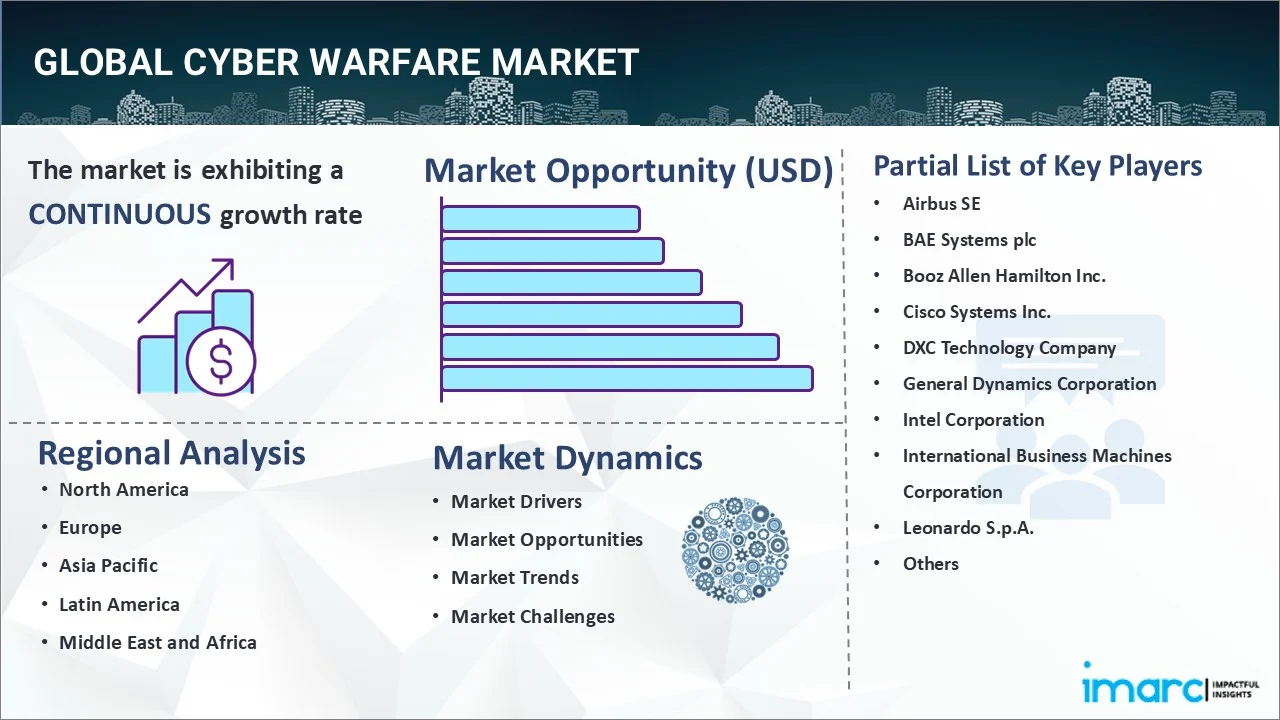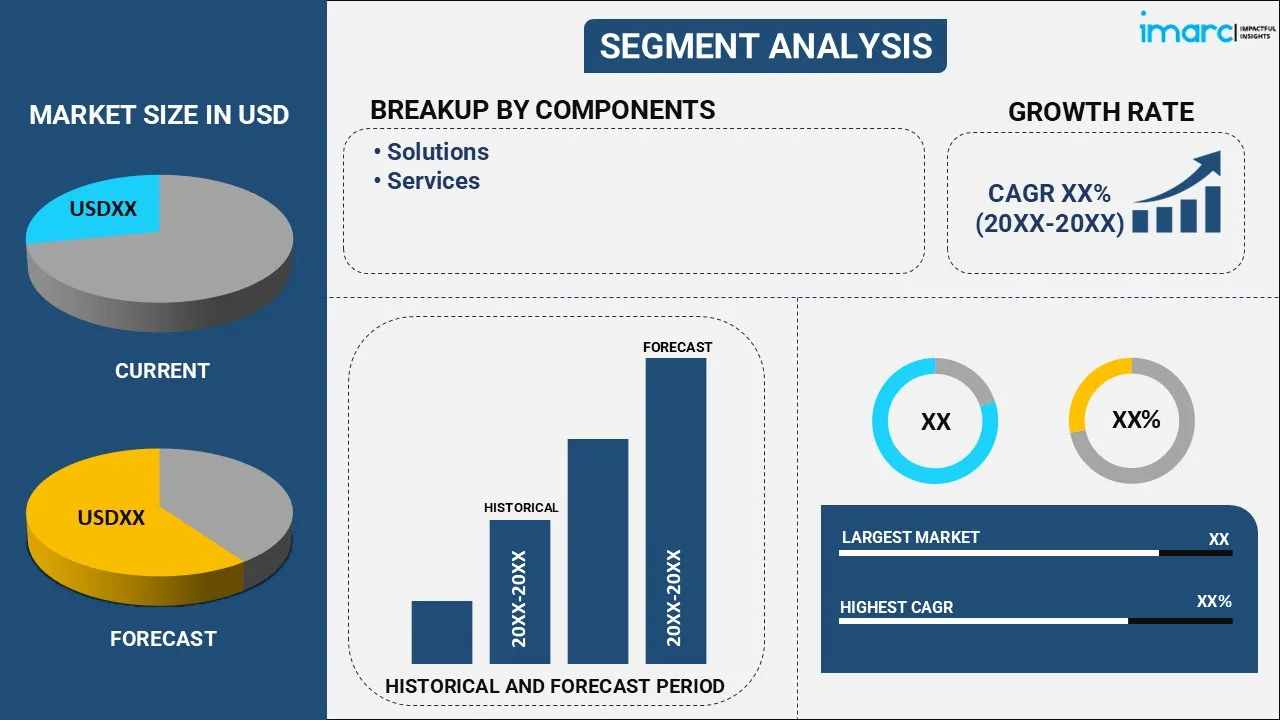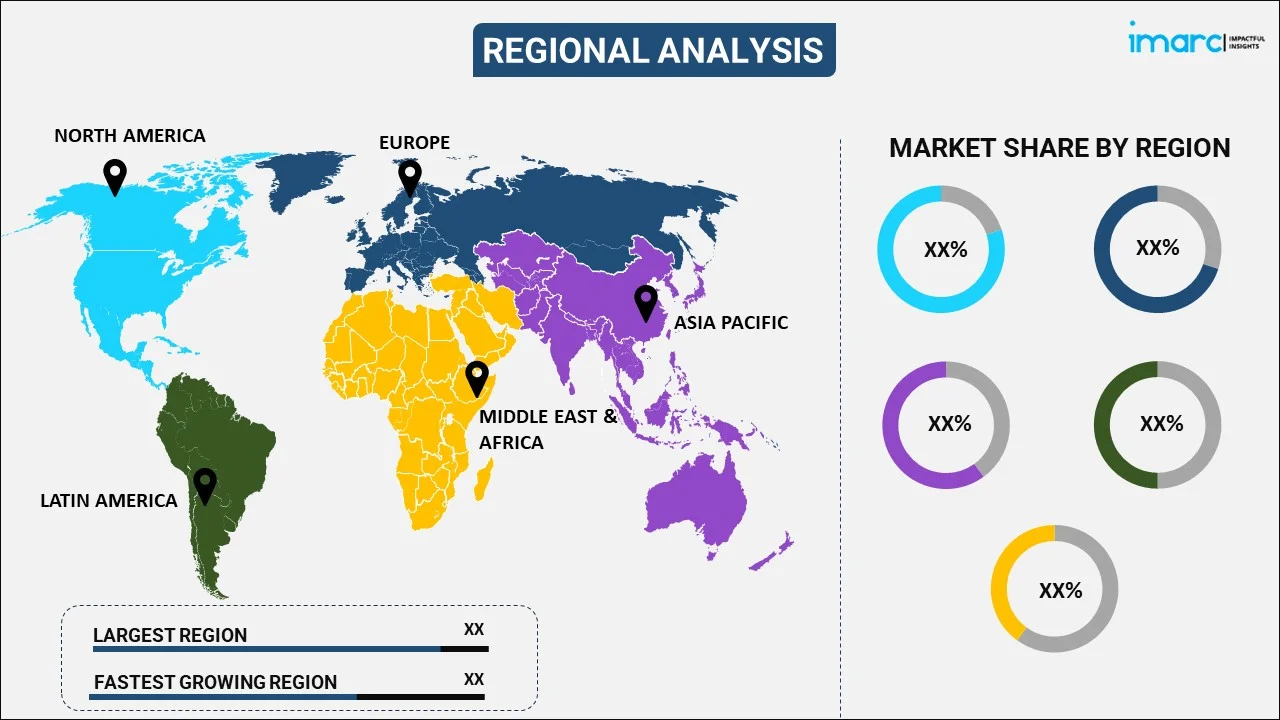
Cyber Warfare Market Report by Component (Solutions, Services), Type (Cyberattacks, Espionage, Sabotage), Application (Aerospace, Corporate, Government and Defense, Homeland, and Others), and Region 2025-2033
Market Overview:
The global cyber warfare market size reached USD 67.4 Billion in 2024. Looking forward, IMARC Group expects the market to reach USD 206.3 Billion by 2033, exhibiting a growth rate (CAGR) of 12.57% during 2025-2033. The increasing number of cyber-attacks on government and military networks, the expanding product adoption across various industries to protect their IT infrastructure, and ongoing product advancements represent some of the key factors driving the market.
|
Report Attribute
|
Key Statistics
|
|---|---|
|
Base Year
|
2024
|
|
Forecast Years
|
2025-2033
|
|
Historical Years
|
2019-2024
|
|
Market Size in 2024
|
USD 67.4 Billion |
|
Market Forecast in 2033
|
USD 206.3 Billion |
| Market Growth Rate 2025-2033 | 12.57% |
Cyber warfare can be defined as the use of a cyberattack or series of attacks that target the computer network systems of other organizations to disrupt, damage, or destroy military resources, financial infrastructure, public safety infrastructure, or other critical systems. These attacks can range from simple phishing attacks to complex malware attacks that can cause significant harm to the targeted systems and networks. The resulting outcome could be espionage, sabotage, propaganda, manipulation, or economic warfare. Cyber warfare finds extensive applications across the aerospace, corporate, government, defense, power and utilities, and banking, financial services, and insurance (BFSI) industries.

Cyber Warfare Market Trends:
The increasing use of cyber warfare by international organizations to safeguard their digital infrastructure and internet-connected devices represents the key factor driving the market growth. Besides this, with the growing number of cyber-attacks on government and military networks, numerous countries are extensively investing in enhancing their cybersecurity capabilities to improve national security, which, in turn, is creating a favorable outlook for the market. Moreover, the surging popularity of cloud-based security solutions, as they offer end-to-end protection of data through encryption, strong passwords, multi-factor authentication, and tested backups, is acting as another significant growth-inducing factor. Concurrent with this, the widespread adoption of the internet of things (IoT) and big data analytics by various organizations are presenting remunerative growth opportunities for the market. In line with this, the largescale demand for artificial intelligence (AI) and machine learning (ML) based cybersecurity software and solutions across various industries is aiding in market expansion. In addition to this, the expanding use of social media and hyper-connectivity has created a need for constant management of cyber breaches in computer systems, which is propelling the demand for cyber warfare. Furthermore, the rise in cyber espionage and cyber-terrorism activities, along with the escalating product employment in military aviation to prevent various threats that could harm aircraft during operations, is positively impacting the market growth.
Key Market Segmentation:
IMARC Group provides an analysis of the key trends in each sub-segment of the global cyber warfare market report, along with forecasts at the global, regional and country level from 2025-2033. Our report has categorized the market based on component, type and application.
Component Insights:

- Solutions
- Services
The report has provided a detailed breakup and analysis of the cyber warfare market based on the component. This includes solutions and services. According to the report, solutions represented the largest segment.
Type Insights:
- Cyberattacks
- Espionage
- Sabotage
A detailed breakup and analysis of the cyber warfare market based on the type has also been provided in the report. This includes cyberattacks, espionage, and sabotage. According to the report, cyberattacks accounted for the largest market share.
Application Insights:
- Aerospace
- Corporate
- Government and Defense
- Homeland
- Others
The report has provided a detailed breakup and analysis of the cyber warfare market based on the application. This includes aerospace, corporate, government and defense, homeland, and others.
Regional Insights:

- North America
- United States
- Canada
- Asia-Pacific
- China
- Japan
- India
- South Korea
- Australia
- Indonesia
- Others
- Europe
- Germany
- France
- United Kingdom
- Italy
- Spain
- Russia
- Others
- Latin America
- Brazil
- Mexico
- Others
- Middle East and Africa
The report has also provided a comprehensive analysis of all the major regional markets, which include North America (the United States and Canada); Asia Pacific (China, Japan, India, South Korea, Australia, Indonesia, and others); Europe (Germany, France, the United Kingdom, Italy, Spain, Russia, and others); Latin America (Brazil, Mexico, and others); and the Middle East and Africa. According to the report, North America was the largest market for cyber warfare. Some of the factors driving the North America cyber warfare market included increasing incidences of cyber espionage and cyber-terrorism activities, the surging demand for cloud, artificial intelligence (AI), and machine learning (ML) based cybersecurity solutions, and favorable government initiatives and investments.
Competitive Landscape:
The report has also provided a comprehensive analysis of the competitive landscape in the global cyber warfare market. Competitive analysis such as market structure, market share by key players, player positioning, top winning strategies, competitive dashboard, and company evaluation quadrant has been covered in the report. Also, detailed profiles of all major companies have been provided. Some of the companies covered include Airbus SE, BAE Systems plc, Booz Allen Hamilton Inc., Cisco Systems Inc., DXC Technology Company, General Dynamics Corporation, Intel Corporation, International Business Machines Corporation, Leonardo S.p.A., Lockheed Martin Corporation, Northrop Grumman Corporation, Raytheon Technologies Corporation, and The Boeing Company. Kindly note that this only represents a partial list of companies, and the complete list has been provided in the report.
Report Coverage:
| Report Features | Details |
|---|---|
| Base Year of the Analysis | 2024 |
| Historical Period | 2019-2024 |
| Forecast Period | 2025-2033 |
| Units | Billion USD |
| Segment Coverage | Component, Type, Application, Region |
| Region Covered | Asia Pacific, Europe, North America, Latin America, Middle East and Africa |
| Countries Covered | United States, Canada, Germany, France, United Kingdom, Italy, Spain, Russia, China, Japan, India, South Korea, Australia, Indonesia, Brazil, Mexico |
| Companies Covered | Airbus SE, BAE Systems plc, Booz Allen Hamilton Inc., Cisco Systems Inc., DXC Technology Company, General Dynamics Corporation, Intel Corporation, International Business Machines Corporation, Leonardo S.p.A., Lockheed Martin Corporation, Northrop Grumman Corporation, Raytheon Technologies Corporation and The Boeing Company. |
| Customization Scope | 10% Free Customization |
| Post-Sale Analyst Support | 10-12 Weeks |
| Delivery Format | PDF and Excel through Email (We can also provide the editable version of the report in PPT/Word format on special request) |
Key Benefits for Stakeholders:
- IMARC’s report offers a comprehensive quantitative analysis of various market segments, historical and current market trends, market forecasts, and dynamics of the cyber warfare market from 2019-2033.
- The research study provides the latest information on the market drivers, challenges, and opportunities in the global cyber warfare market.
- The study maps the leading, as well as the fastest-growing, regional markets. It further enables stakeholders to identify the key country-level markets within each region.
- Porter's five forces analysis assist stakeholders in assessing the impact of new entrants, competitive rivalry, supplier power, buyer power, and the threat of substitution. It helps stakeholders to analyze the level of competition within the cyber warfare industry and its attractiveness.
- Competitive landscape allows stakeholders to understand their competitive environment and provides an insight into the current positions of key players in the market.
Key Questions Answered in This Report
The cyber warfare market was valued at USD 67.4 Billion in 2024.
IMARC estimates the cyber warfare market to exhibit a CAGR of 12.57% during 2025-2033.
The market is primarily driven by increasing cyber-attacks on government and military networks, growing adoption of cybersecurity solutions across industries, continual advancements in AI and ML-based security tools, rising popularity of cloud-based security, widespread IoT adoption, and heightened concerns over cyber espionage and terrorism.
On a regional level, the market has been classified into North America, Asia Pacific, Europe, Latin America, and Middle East and Africa, wherein North America currently dominates the market.
Some of the major players in the cyber warfare market include Airbus SE, BAE Systems plc, Booz Allen Hamilton Inc., Cisco Systems Inc., DXC Technology Company, General Dynamics Corporation, Intel Corporation, International Business Machines Corporation, Leonardo S.p.A., Lockheed Martin Corporation, Northrop Grumman Corporation, Raytheon Technologies Corporation and The Boeing Company, among others.
Need more help?
- Speak to our experienced analysts for insights on the current market scenarios.
- Include additional segments and countries to customize the report as per your requirement.
- Gain an unparalleled competitive advantage in your domain by understanding how to utilize the report and positively impacting your operations and revenue.
- For further assistance, please connect with our analysts.
 Inquire Before Buying
Inquire Before Buying
 Speak to an Analyst
Speak to an Analyst
 Request Brochure
Request Brochure
 Request Customization
Request Customization




.webp)




.webp)












